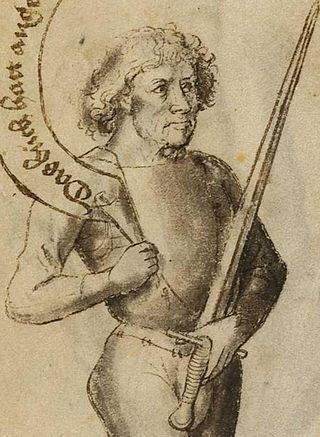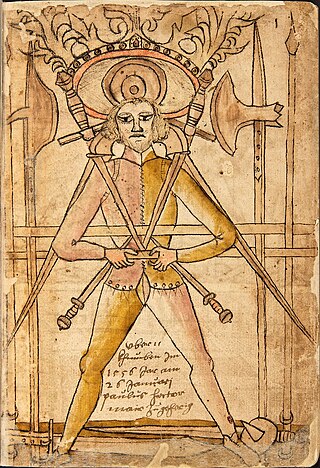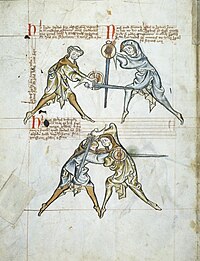
A rapier or espada ropera is a type of sword with a slender and sharply pointed two-edged blade that was popular in Western Europe, both for civilian use and as a military side arm, throughout the 16th and 17th centuries.

A longsword is a type of European sword characterized as having a cruciform hilt with a grip for primarily two-handed use, a straight double-edged blade of around 80 to 110 cm, and weighing approximately 1 to 1.5 kg.

Hans Talhoffer was a German fencing master. His martial lineage is unknown, but his writings make it clear that he had some connection to the tradition of Johannes Liechtenauer, the grand master of a well-known Medieval German school of fencing. Talhoffer was a well-educated man who took interest in astrology, mathematics, onomastics, and the auctoritas and the ratio. He authored at least five fencing manuals during the course of his career, and appears to have made his living teaching, including training people for trial by combat.

Fiore Furlano de Cividale d'Austria, delli Liberi da Premariacco was a late 14th century knight, diplomat, and itinerant fencing master.

A buckler is a small shield, up to 45 cm in diameter, gripped in the fist with a central handle behind the boss. It became more common as a companion weapon in hand-to-hand combat during the Medieval and Renaissance periods. Its size made it poor protection against missile weapons but useful in deflecting the blow of an opponent's weapons, binding his arms, hindering his movements, or punching him.

Johannes Liechtenauer was a German fencing master who had a great level of influence on the German fencing tradition in the 14th century.
Langort is a position in the German School of historical fencing. In the Langort position, the point of the sword is extended. The term appears first in Royal Armouries Ms. I.33.

Historical European martial arts (HEMA) are martial arts of European origin, particularly using arts formerly practised, but having since died out or evolved into very different forms.
Martial arts manuals are instructions, with or without illustrations, specifically designed to be learnt from a book. Many books detailing specific techniques of martial arts are often erroneously called manuals but were written as treatises.

The German school of fencing is a system of combat taught in the Holy Roman Empire during the Late Medieval, German Renaissance, and Early Modern periods. It is described in the contemporary Fechtbücher written at the time. The geographical center of this tradition was in what is now Southern Germany including Augsburg, Frankfurt, and Nuremberg. During the period in which it was taught, it was known as the Kunst des Fechtens, or the "Art of Fighting". The German school of fencing focuses primarily on the use of the two-handed longsword; it also describes the use of many other weapons, including polearms, medieval daggers, messers, and the staff, as well as describing mounted combat and unarmed grappling (ringen).

Sigmund Schining ein Ringeck was a German fencing master. While the meaning of the surname "Schining" is uncertain, the suffix "ain Ringeck" may indicate that he came from the Rhineland region of south-western Germany. He is named in the text of his treatise as Schirmaister to one Duke Albrecht, Count Palatine of Rhine and Duke of Bavaria. Other than this, the only thing that can be determined about his life is that his renown as a master was sufficient for Paulus Kal to include him on his memorial to the deceased masters of the Society of Liechtenauer in 1470. Ringeck seems to have authored one of the few complete glosses of the epitome of the grand master Johannes Liechtenauer, making him one of the most important German fencing masters of the 15th century.

The Gladiatoria Group is a series of several 15th-century German manuscripts that share the same art style and cover the same material—various types of armored combat. The texts are contemporary with the tradition of Johannes Liechtenauer, but not directly influenced by it. Gladiatoria is thus one of very few glimpses into the characteristics of a potentially independent German martial tradition.

The term Italian school of swordsmanship is used to describe the Italian style of fencing and edged-weapon combat from the time of the first extant Italian swordsmanship treatise (1409) to the days of Classical Fencing.

Joachim Meyer was a self described Freifechter living in the then Free Imperial City of Strasbourg in the 16th century and the author of a fechtbuch Gründtliche Beschreibung der Kunst des Fechtens first published in 1570.

Bem cavalgar, fully Livro da ensinança de bem cavalgar toda sela, is a book written by Edward of Portugal, left incomplete as Edward died of a plague in 1438. It is one of the oldest remaining manuals of medieval horsemanship and jousting. Together with Leal Conselheiro, the other book written by King Edward, the manuscript is kept at the French National Library, Paris. It is the basis of the curriculum at the Portuguese School of Equestrian Art, one of the Big Four riding academies.
The oldest surviving manual on western swordsmanship dates back to the 14th century, although historical references date fencing schools back to the 12th century.
The Chicago Swordplay Guild is a modern school of swordsmanship and Western martial arts, and non-profit organization based in Chicago, Illinois, United States. It provides organized instruction in the study and practice of historical European swordplay, with a principal focus on the Italian school of swordsmanship and other martial arts of the 14th–17th centuries. Co-founded in 1999 by Gregory Mele and Mark Rector, the Chicago Swordplay Guild seeks to be consistent with the methodology of the ancient European fencing schools by combining scholarship and research into the teachings of the historical Masters, with the practical knowledge gained through solo and partnered drilling and fencing. Since techniques are taught in reference to how effective they would be in a real encounter, the Guild practices with an absolute emphasis on safety, control, competence, and skill at arms.
Brian R. Price is an American university professor, historical fencing instructor, and member of the Society for Creative Anachronism. He taught at Hawai'i Pacific University, until some time before Nov. 11, 2022, when he was not listed among the faculty there. As of Nov. 10, 2022, Price is listed as "an Associate Professor in the Department of Joint Warfighting at the Air Command and Staff College", Air University at Maxwell AFB in Alabama
Chivalry Bookshelf was a small press based in the United States founded by Brian R. Price which published booklets and books from 1992 to 2007. It was most notable for its contributions to the Society of Creative Anachronism and the early historical fencing movement and for a dispute about plagiarism and nonpayment of royalties in 2011-12.

Gründtliche Beschreibung der Kunst des Fechtens or, in English: A Foundational Description of the Art of Fencing: A Thorough Description of the Free, Knightly and Noble Art of Fencing, Showing Various Customary Defenses, Affected and Put Forth with Many Handsome and Useful Drawings is a German fencing manual that was published in 1570. Its author was the Freifechter Joachim Meyer. This manual was made for and was dedicated to Meyer's patron Count Palatine Johann Casimir. This fechtbuch builds on his earlier work, a manuscript written in 1560 - the MS A.4°.2, and presents a complex, multi-weapon treatise. Meyer's complete system often marks the end of and the compilation of the German fencing system in the Johannes Liechtenauer tradition. It is the only fechtbuch in the Liechtenauer tradition that was written for both laymen and beginners of the art.















